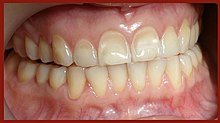Erosion (dentistry)
In dentistry, erosion is an indistinctly limited loss of hard tooth substance due to the effects of various acids .
Exogenous causes
The acids can be supplied from outside ( fruit acids in fruit, fruit juices, lemonades, energy drinks , fruit teas, iced teas , sweets ; oxalic acid in rhubarb and spinach ; vinegar or lactic acid (in sauerkraut , sour milk products )) or they can be produced by the body itself.
The stimulation of saliva production by acids has a compensating effect , which leads to a dilution and neutralization of the acids, their faster removal and a remineralization of the tooth enamel .
Endogenous causes
The latter is the hydrochloric acid of the gastric juice , which at a reflux disease (acid reflux) or vomiting can pass into the oral cavity or passes. Dental erosions can lead to the diagnosis of a silent (otherwise asymptomatic) reflux disease. The palatal surfaces of the front teeth of the upper jaw and the occlusal surfaces of the posterior teeth are primarily affected . In addition, erosive changes in the teeth can indicate chronic vomiting, although the presence of a mental eating disorder ( anorexia nervosa , or bulimia ) must be considered.
Other possibilities for a loss of tooth substance are bruxism (the nocturnal grinding of teeth) and abrasion from strongly abrasive toothpastes , toothbrushes that are too hard or excessive pressure when brushing your teeth .
Furthermore, the cause can also lie in reduced saliva production . By diseases , medications and drugs , it may be that because of overstimulation of the sympathetic saliva - where the remineralization is formed inadequate - makes the teeth. This occurs particularly with amphetamines , such as crystal meth . This clinical picture is therefore known as meth mouth .
Individual evidence
- ^ Enno Kramer: Prophylaxis primer: Basics of dental health care . Deutscher Ärzteverlag, 2004, ISBN 3-934280-66-8 , p. 69 ( limited preview in Google Book search).
- ^ DA Ali, RS Brown, LO Rodriguez, EL Moody, MF Nasr: Dental erosion caused by silent gastroesophageal reflux disease . In: J Am Dent Assoc . tape 133 , no. 6 , 2002, pp. 734-737 , PMID 12083649 . (Full text; engl.)
- ↑ BL Gregory-Head, DA Curtis, L. Kim, J. Cello: Evaluation of dental erosion in patients with gastroesophageal reflux disease . In: J Prosthet Dent . tape 83 , no. 6 , 2000, pp. 675-680 , PMID 10842138 .
- ↑ A. Dahshan, H. Patel, J. Delaney, A. Wuerth, R. Thomas, V. Tolia: Gastroesophageal reflux disease and dental erosion in children . In: J Pediatr . tape 140 , no. 4 , 2002, p. 474-478 , PMID 12006966 .
- ↑ F. Pace, S. Pallotta, M. Tonini, N. Vakil, G. Bianchi Porro: Systematic review: gastro-oesophageal reflux disease and dental lesions . In: Aliment Pharmacol Ther . tape 27 , no. 12 , 2008, p. 1179-1186 , PMID 18373634 .
